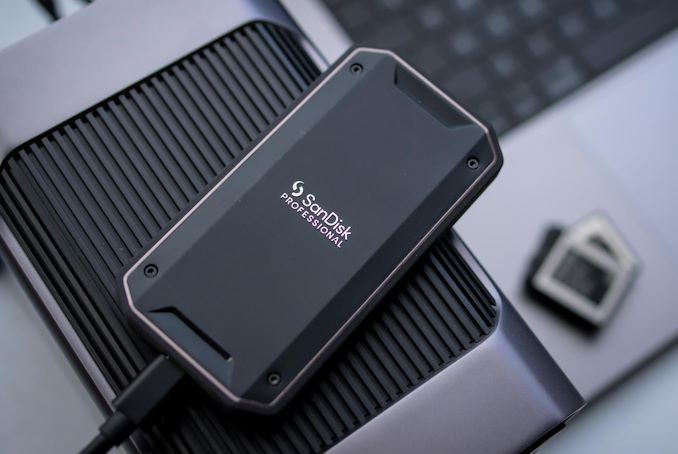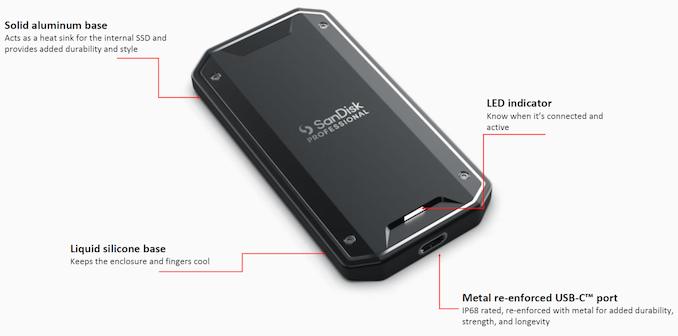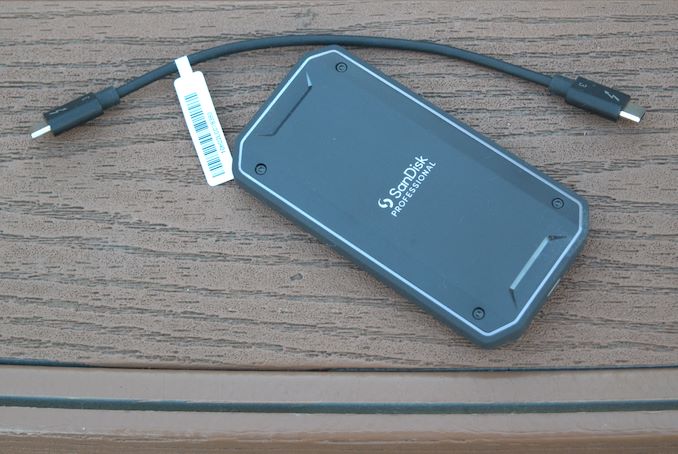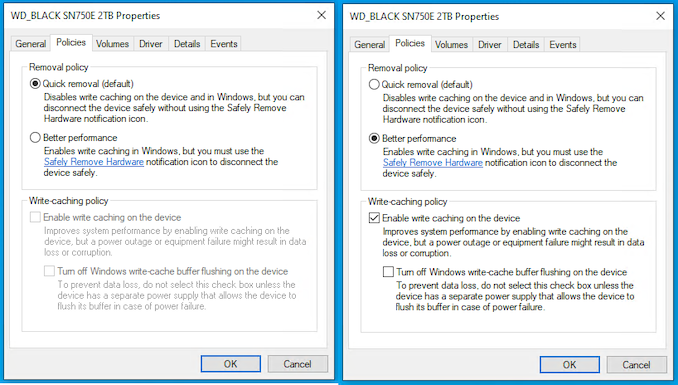SanDisk Professional PRO-G40 Thunderbolt / USB Dual-Mode Portable SSD Review
by Ganesh T S on October 6, 2022 8:00 AM EST
Western Digital is introducing a new flagship portable SSD today under the SanDisk Professional brand. The PRO-G40 dual-mode PSSD ticks all the right boxes for prosumers, content creators, and studios looking for a high-performance rugged bus-powered portable storage drive with wide compatibility. 1TB and 2TB versions are available. While the PSSD delivers its maximum performance (close to 3GBps) when connected to Thunderbolt 3 hosts, it can also work as a 1GBps-class drive when connected to a USB 3.2 Gen 2 host port. Western Digital provided us with a 2TB sample of the PRO-G40 to put through our rigorous direct-attached storage evaluation.
Introduction
External bus-powered storage devices have grown both in storage capacity as well as speeds over the last decade. Thanks to rapid advancements in flash technology (including the advent of 3D NAND and NVMe) as well as faster host interfaces (such as Thunderbolt 3 and USB 3.x), we now have palm-sized flash-based storage devices capable of delivering 3GBps+ speeds. While those speeds can be achieved with Thunderbolt 4, mass-market devices have to rely on USB. Within the USB ecosystem, USB 3.2 Gen 2 (10 Gbps) is fast becoming the entry level for thumb drives and portable SSDs.
The initial wave of Thunderbolt 3-based portable SSDs and enclosures offered impressive performance, but market acceptance was limited by their incompatibility with traditional USB ports. Intel's Titan Ridge controllers offered an interesting feature when used in client devices such as peripherals and/or docks. In addition to downstream PCIe lanes, an USB 3.2 Gen 2 host interface was also included. This allowed manufacturers to offer unique dual-mode designs by tweaking the traditional JHL7440 Thunderbolt 3 SSD. The USB 3.2 Gen 2 downstream port is connected to the upstream interface of a USB to NVMe bridge chip. Depending on the host to which the drive is connected (reported by the JHL7440), the PCIe 3.0 x4 lanes of the NVMe SSD are connected to either the JHL7440's downstream PCIe 3.0 x4 lanes or the bridge chip's PCIe 3.0 x4 lanes. The Sabrent ROCKET XTRM-Q was one of the first PSSD lineups to support dual-mode operation based on this architecture.
Western Digital is joining the dual-mode bandwagon today with the SanDisk Professional PRO-G40 Portable SSD. The PSSD uses the WD_BLACK SN750E M.2 2280 drive internally. On the bridge side, the JHL7440 Titan Ridge Thunderbolt 3 controller is augmented by the ASMedia ASM2362 USB 3.2 Gen 2 - NVMe bridge chip. The enclosure itself is quite stylish, and is made of solid aluminum. One side is covered by a silicone base. The drive also includes a LED indicator and a metal-reinforced USB-C port.
These features allow the PRO-G40 to obtain an IP68 rating - complete protection against dust ingress, and no damage resulting from complete and continuous impression under 1m of water. The solid aluminum core allows for drop- (up to 3m) and crush-resistance (up to 4000 lbs.) also, while supporting faster heat dissipation as part of the thermal solution.
The PRO-G40 PSSD comes in a minimal package with the main unit and a short 20cm Thunderbolt 3 passive cable. The length could be a concern for typical desktops, but the use-case for these dual-mode drives mostly involves notebooks or systems that utilize a Thunderbolt dock as part of the workspace.
The drive comes formatted for Macs out of the box, but it is trivial to reformat in one's OS of choice. Our sample was evaluated with the exFAT filesystem on a Windows 10 machine. The 'issues' plaguing all Thunderbolt SSDs on Windows affect the SanDisk Professional PRO-G40 too. Unless write caching is enabled in the volume policies for the Thunderbolt port-connected drive, the write performance doesn't match the expectations / advertised numbers.
Our policy is to evaluate all external storage devices with default OS settings - and this has been for quick removal since we moved to Windows 10 on our new testbed. However, we did evaluate the PRO-G40 drive thrice - once connected to a Thunderbolt 3 port, and another time connected to a USB 3.2 Gen 2x2 port enabled by the ASMedia ASM2342 controller. In our final pass, we repeated the evaluation procedure with the write cache settings modified, as shown in the picture below (default settings on the left, and modified one on the right).
CrystalDiskInfo provides a quick overview of the PSSD as seen by the host system. The interface section is of particular interest - NVM Express over Thunderbolt, and UASP (NVM Express) over USB 3.2 Gen 2x2 Type-C.
| S.M.A.R.T Passthrough - CrystalDiskInfo | |
 |
 |
The table below presents a comparative view of the specifications of the different PSSDs presented in this review.
| Comparative Direct-Attached Storage Devices Configuration | ||
| Aspect | ||
| Downstream Port | PCIe 3.0 x4 | PCIe 3.0 x4 |
| Upstream Port | Thunderbolt 3 and USB 3.2 Gen 2 Type-C | Thunderbolt 3 and USB 3.2 Gen 2 Type-C |
| Bridge Chip | Intel JHL7440 + ASMedia ASM2362 | Intel JHL7440 + ASMedia ASM2362 |
| Power | Bus Powered | Bus Powered |
| Use Case | Dual mode Thunderbolt / USB high-performance rugged portable SSD with a durability focus (IP68 rating) | Dual mode Thunderbolt / USB high-performance rugged portable SSD with a durability focus (IP68 rating) |
| Physical Dimensions | 109.5 mm x 57 mm x 12 mm | 109.5 mm x 57 mm x 12 mm |
| Weight | 122.3 grams | 122.3 grams |
| Cable | 20 cm Thunderbolt 3 40Gbps Type-C to Type-C | 20 cm Thunderbolt 3 40Gbps Type-C to Type-C |
| S.M.A.R.T Passthrough | Yes | Yes |
| UASP Support | Yes | Yes |
| TRIM Passthrough | Yes | Yes |
| Hardware Encryption | No | No |
| Evaluated Storage | WD_BLACK SN750E (SanDisk ??L BiCS? 3D TLC) | WD_BLACK SN750E (SanDisk ??L BiCS? 3D TLC) |
| Price | USD 450 | USD 450 |
| Review Link | SanDisk Professional PRO-G40 SSD 2TB Review | SanDisk Professional PRO-G40 SSD 2TB Review |
Prior to looking at the benchmark numbers, power consumption, and thermal solution effectiveness, a description of the testbed setup and evaluation methodology is provided.
Testbed Setup and Evaluation Methodology
Direct-attached storage devices are evaluated using the Quartz Canyon NUC (essentially, the Xeon / ECC version of the Ghost Canyon NUC) configured with 2x 16GB DDR4-2667 ECC SODIMMs and a PCIe 3.0 x4 NVMe SSD - the IM2P33E8 1TB from ADATA.
The most attractive aspect of the Quartz Canyon NUC is the presence of two PCIe slots (electrically, x16 and x4) for add-in cards. In the absence of a discrete GPU - for which there is no need in a DAS testbed - both slots are available. In fact, we also added a spare SanDisk Extreme PRO M.2 NVMe SSD to the CPU direct-attached M.2 22110 slot in the baseboard in order to avoid DMI bottlenecks when evaluating Thunderbolt 3 devices. This still allows for two add-in cards operating at x8 (x16 electrical) and x4 (x4 electrical). Since the Quartz Canyon NUC doesn't have a native USB 3.2 Gen 2x2 port, Silverstone's SST-ECU06 add-in card was installed in the x4 slot. All non-Thunderbolt devices are tested using the Type-C port enabled by the SST-ECU06.
The specifications of the testbed are summarized in the table below:
| The 2021 AnandTech DAS Testbed Configuration | |
| System | Intel Quartz Canyon NUC9vXQNX |
| CPU | Intel Xeon E-2286M |
| Memory | ADATA Industrial AD4B3200716G22 32 GB (2x 16GB) DDR4-3200 ECC @ 22-22-22-52 |
| OS Drive | ADATA Industrial IM2P33E8 NVMe 1TB |
| Secondary Drive | SanDisk Extreme PRO M.2 NVMe 3D SSD 1TB |
| Add-on Card | SilverStone Tek SST-ECU06 USB 3.2 Gen 2x2 Type-C Host |
| OS | Windows 10 Enterprise x64 (21H1) |
| Thanks to ADATA, Intel, and SilverStone Tek for the build components | |
The testbed hardware is only one segment of the evaluation. Over the last few years, the typical direct-attached storage workloads for memory cards have also evolved. High bit-rate 4K videos at 60fps have become quite common, and 8K videos are starting to make an appearance. Game install sizes have also grown steadily even in portable game consoles, thanks to high resolution textures and artwork. Keeping these in mind, our evaluation scheme for direct-attached storage devices involves multiple workloads which are described in detail in the corresponding sections.
- Synthetic workloads using CrystalDiskMark and ATTO
- Real-world access traces using PCMark 10's storage benchmark
- Custom robocopy workloads reflective of typical DAS usage
- Sequential write stress test
In the next section, we have an overview of the performance of the SanDisk Professional PRO-G40 2TB PSSD in these benchmarks. Prior to providing concluding remarks, we have some observations on the device's power consumption numbers and thermal solution also.














13 Comments
View All Comments
Chaitanya - Thursday, October 6, 2022 - link
WD are mudding the waters a lot with far too many products and far too many occurrences of bait and switch for SKUs. Seems like for now Samsung and Seagate remain "safe" options.hubick - Friday, October 7, 2022 - link
This is nothing new over the LaCie Rugged SSD Pro I got back in 2020. When are we gonna see an integrated Thunderbolt/USB4 + flash controller, like the Silicon Motion SM2320 is for USB 2x2?schmadde - Saturday, November 5, 2022 - link
More competition will eventually lead to lower prices - at least I hope so.According to this test the Sandisk is significantly faster than the LaCie, though.
R3MF - Friday, October 7, 2022 - link
I mean, it's lovely that they have made this product, but literally the only thing i want to see from WD's protable drive division is a USB4 product that can do full drive capacity writes at speeds greater than that achievable by USB 3.2x2.Make me one of those.
Exotica - Friday, October 7, 2022 - link
It’s better to just get a better performing drive such as a sn770 or sn850 or Samsung 980 pro and slap it in a thunderbolt enclosure, such as that made by Acasis, and you will get excellent performance. I’ve been doing this for a couple years now…hubick - Friday, October 7, 2022 - link
Last I checked there were no enclosures that had USB fallback compatibility though?shanti_shakti - Sunday, October 9, 2022 - link
There are many such TB3/USB fallback enclosures available, and they have been available for a long time.I’ve using a couple from ‘Acasis’ for around a year now, with Samsung 980 Pro drives inside. Work perfectly via TB3 and USB.
schmadde - Saturday, November 5, 2022 - link
Would you name the "many" TB+USB enclosures? I only know a handful of TB enclosures and most of them are either slow (sometimes only 2 PCIe lanes connected) or don't have USB Fallback and all of them are quite expensive, so the price difference to the sandisk is not huge at least for 1 TB and if you match it with an SSD that is as fast probably negligible.The Acasis/Delock I have myself and it has compatibility issues. My 970 Evo Plus while quite fast inside a computer is very slow in the Acasis case.
I just checked prices: the USD prices listed in the article look o.k., but the EU prices are outrageous. The 1 TB drive is as much over here as the 2 TB in the US. For this price they can keep it
Techie2 - Monday, October 10, 2022 - link
What I want to know is where are all of those Gen 5 internal SSDs that were suppose to be available for purchase in Oct. '22? What a crock to promote products that can't be purchased.Ryan Smith - Tuesday, October 11, 2022 - link
They will not be available until November.As far as I can recall, this was always the plan; no one announced availability for October.
https://images.anandtech.com/doci/17550/52687281.j...